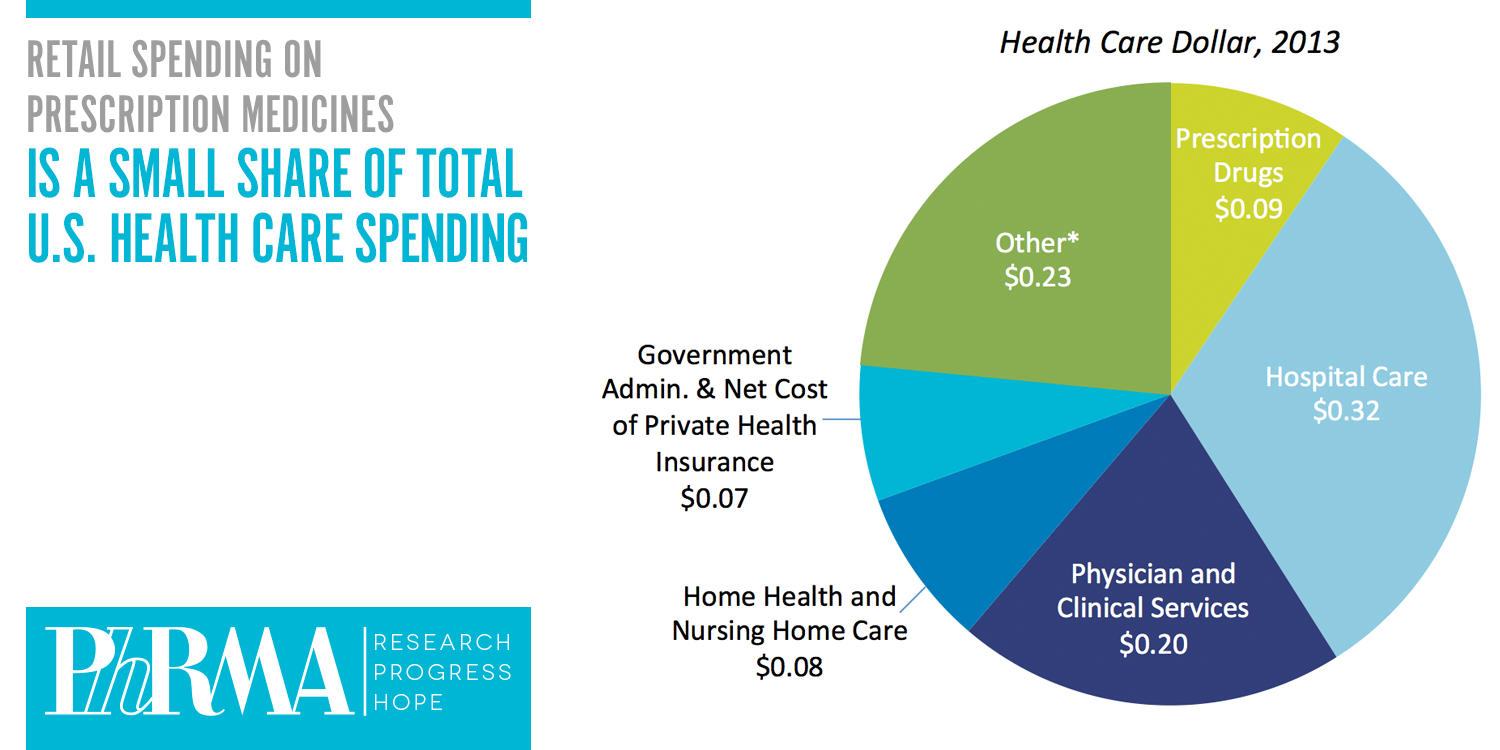
The Five Essential Truths about Prescription Drug Spending
17 March 2015
Every day patients around the world are living healthier, more productive lives thanks to innovative medicines developed by biopharmaceutical companies. Retail prescription medicines have consistently accounted for just 10 percent of United States health care spending and federal actuaries project this share will remain stable through the next decade. At the same time, these medicines have helped to curb downstream health care system costs by reducing spending on expensive hospitalizations and long-term care.

Any discussion of prescription drug spending needs to consider the following five facts:
- Government data shows that retail prescription medicines will continue to account for just 10 percent of U.S. health care spending through the next decade.
Contrary to recent rhetoric, prescription medicines are a small share of total health care spending and the most recent national health spending projections show that it is expected to grow at rates in line with overall health care spending through 2023. To put this in context, private insurers spent roughly as much on drugs as on administrative costs in 2013 and the U.S. will spend $13.6 trillion on hospital care over the next decade, more than three times total spending on prescription medicines. - 2014 was an unusual year, in which roughly 10 million of uninsured patients gained coverage, and a record number of new medicines were approved.
Increases in health care costs were expected in 2014, given the expansion of insurance coverage under the Affordable Care Act. In addition, the U.S. Food and Drug Administration’s Center for Drug Evaluation and Research (CDER) approved a record number of 41 new medicines, of which nearly 41 percent were first in class treatments, and more than 20 percent were personalized medicines. Among the new medicines are innovative cancer treatments with the potential to prolong and transform patients’ lives, therapies for hepatitis C with cure rates of more than 90 percent, and a record-setting 17 medicines to treat rare diseases. - The Express Scripts drug trend report doesn’t tell the full story because it focuses on a small subset of medicines and excludes rebates from their calculations.
While Express Scripts has claimed it will save the U.S. $4 billion annually as a result of its aggressive negotiations for hepatitis C medicines, they appear to exclude such savings in their public estimates of drug spending. This is surprising since public reports indicate that private payers are receiving discounts of up to 40 percent for hepatitis C medicines. In fact, published estimates of rebates paid by manufacturers put the total at $40 billion per year. In addition, a recent actuarial analysis of pharmacy benefit manager drug trend reports show that trends for “specialty” medicines are frequently misleading, and often use inconsistent definitions and methods which can inflate and bias reported trends. - Medicines can play a crucial role in controlling future health care costs.
Many medicines shift the treatment paradigm toward prevention by allowing patients to avoid expensive hospital and long-term care. And every additional dollar spent on medicines for adherent patients with congestive heart failure, high blood pressure, diabetes and high cholesterol generated $3 to $10 dollars in savings on emergency room visits and inpatient hospitalizations. - Medicines help patients live longer, healthier lives.
In many cases, research and medicines from the biopharmaceutical sector are the only chance for survival for patients and their families. Medicines have helped raise average U.S. life expectancy from 47 years in 1900 to 78 years. Since its peak in 1991, the cancer death rate in the U.S. has fallen 22 percent and 2 out of 3 patients diagnosed with cancer are living at least 5 years following diagnosis. And new hepatitis C therapies have cure rates above 90% and dramatically decrease the burden of the disease on the U.S. health care system and the economy.
Our news
-
14 March 2024
-
26 February 2024
-
NovaMedica team wishes you a Merry Christmas and a Happy New Year!
26 December 2023
Media Center
-
Big Pharma’s ROI for drug R&D saw 'welcome' rebound in 2023: report
25 April 2024
-
Orphan drug market to reach $270B by 2028 : Evaluate
25 April 2024
-
Russian drug for the treatment of viral hepatitis will be exempt from duty in Mongolia
24 April 2024
-
PM Mishustin: “We need to increase the production of vital and essential drugs in Russia”
24 April 2024